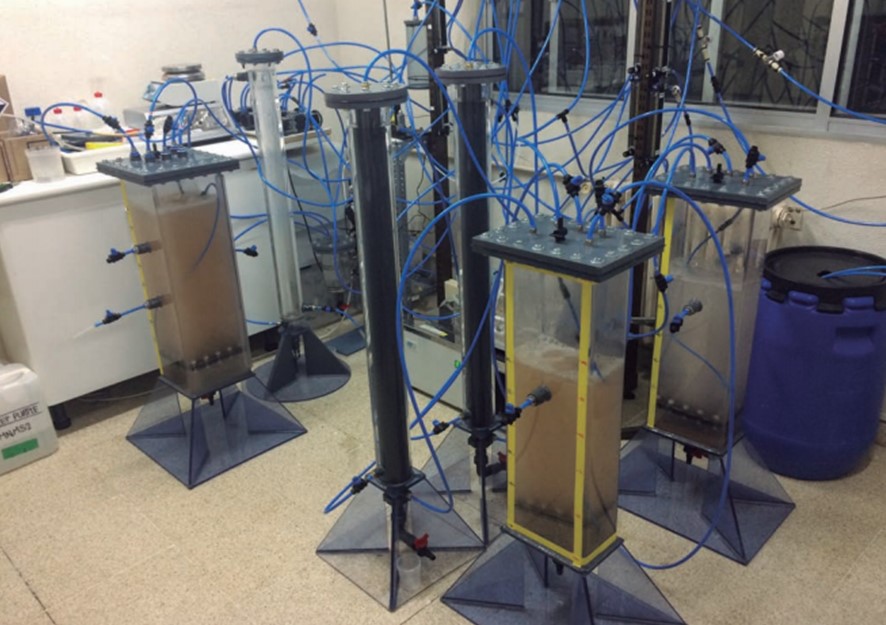Urban waste constitutes a serious environmental problem for the entire world population. In Europe, 138 M tonnes of urban bio-waste are generated annually, of which 75% are incinerated or deposited in landfills. The Waste Directive requires that, in 2020, half of this waste be reused or recycled, reaching 60% in 2030.
The main objective of waste treatment plants is to reduce the volume of municipal solid waste through anaerobic digestion or composting. In wastewater treatment plants, urban wastewater is treated using active sludge systems, with high operating costs and high energy demand. These methods imply a high carbon footprint and most of the nutrients and resources present are dissipated, rather than recovered. The heterogeneity of waste and its variable degree of dilution makes efficient waste management difficult, and poses a challenge for the transition towards a sustainable circular bioeconomy.
The Deep Purple project (www.deep-purple.eu), co-funded by the H2020 Research and Innovation Framework Program and the BIC (Bio-based Industries Consortium), and coordinated by Aqualia, was created with the aim of overcoming these challenges through development and demonstration of a novel photobiorefinery concept. This concept combines optimized bio-waste pre and post-treatment technologies with modern technology for the synergistic treatment of wastewater and the organic fraction of urban waste based on the use of purple phototrophic bacteria.

Diagram of the DEEP PURPLE concept with the three platforms that compose it: (i) biogas platform, where ectoin is generated, (ii) biomass platform, where bio-fertilizers and bio-plastics are obtained, and (iii) cellulose platform , focused on the generation of self-repairing construction materials (Zamora et al 2020).
In just three years, this technology has reached pilot scale, proving to be an alternative to conventional domestic wastewater treatment. This 100% solar anaerobic purification system allows to obtain twice the energy consumed to keep the process in operation. Furthermore, the photo-biorefinery is complemented by the integration of three platforms (cellulose, biomass and biogas), for the generation of bio-products such as bio-fertilizers, bio-plastics, cosmetics and construction materials.
The purpose of the cellulose platform is to recover cellulosic material present in urban wastewater for reuse as a raw material for the formulation of bio-composites in construction materials and coatings for bio-fertilizers.

Cellulose recovery system (left), cellulose-free wastewater outlet (center) and dehydrated recovered cellulose (right) (Zamora et al 2020).
In the phototrophic biomass platform, the treatment of two urban waste is combined, urban wastewater and the organic fraction of urban waste. The mixing ratio between both residual fractions allows optimizing the operation of the photo-biorefinery for the growth of phototrophic biomass, the main raw material for the production of organic fertilizers or for the production of PHA, which are the basis of bio-plastics generated as a final product in DEEP PURPLE.

Pilot-scale photo-biorefinery installed at the URJC Campus of Móstoles, composed of: a) steam explosion hydrolyzer for the treatment of the organic fraction of urban waste, b) solar photo-bioreactors with truncated-conical sedimentation for the joint treatment of the liquid fraction of the hydrolyzate of the organic fraction of urban waste and urban wastewater, c) centrifuge for phototrophic biomass, d) microwave pasteurizers for organic fertilizers and e) infrared tray dryers for organic fertilizers (Zamora et al 2020).
In the biogas platform, the biogas produced from the digestion of the organic fraction of urban waste, can be converted by the action of methanotrophic microorganisms into high added value products, precursors of the chemical industry or fine chemical products such as ectoin. Ectoin is an amino acid that some bacteria accumulate inside to prevent cell breakdown by osmosis under saline stress. Its ability to protect DNA from ultraviolet radiation has made it a highly valued active compound in the cosmetic industry in recent years.
The Institute of Sustainable Processes of the University of Valladolid (ISP) within the DEEP PURPLE project, investigates the transformation of the biogas produced from the FORSU digestion into ectoin, through the use of halophilic consortia in high transfer bioreactors. To date, 3 consortia have been enriched from saline environments in Spain, and the influence of salt concentration, temperature and presence of tungsten on the growth and accumulation of ectoin (up to 10%) has been evaluated. The process will be validated at a scale of 2m³ in the plant from the data that is being obtained in pilot systems of 20 L at the University of Valladolid.

High transfer bioreactors for the bioconversion of biogas into ectoin operated at the Institute of Sustainable Processes of the University of Valladolid.
References:
Deep Purple webpage: https://deep-purple.eu/
Zamora. P, Monsalvo. V, Marín. E, Muñoz. R, Carmona. A, Villamil. J, Melero. J.A, Martínez. F, Rogalla. F, Puyol. D (2020). Recuperación de recursos a partir de biorresiduos y energía solar en foto-biorrefinerías. Proyecto Deep Purple. https://aclima.eus/wp-content/uploads/2020/05/RETEMA221.pdf



